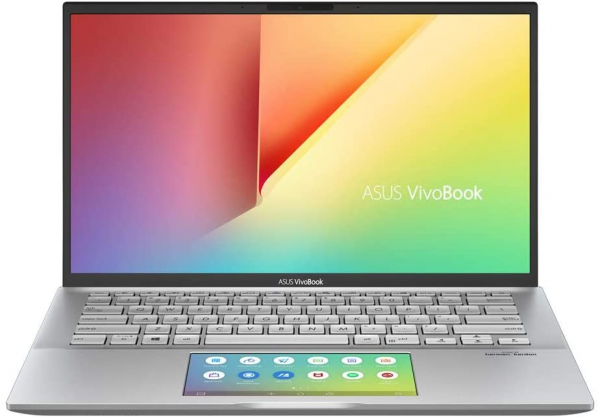Asus
Test: Asus Vivobook S14 with ScreenPad: a second screen to double its productivity?
Aprox. 749€
See specificationsAsus does not want to reserve its ScreenPad for its high-end models. The manufacturer has indeed placed it on its Vivobook S14, which thus enjoys a second screen directly integrated into the trackpad. What to double its productivity?
Our review
Presentation
The ScreenPad is the great concept on which Asus relies a lot. Presented during IFA 2018, this technology consists of placing a second (touch) screen directly in the trackpad, in order to extend the display and make life easier for the user thanks to various shortcuts. Initially, the ScreenPad was reserved for the beg high-end models, the Zenbooks, but Asus now offers it on cheaper PCs, such as the Vivobook S14 which costs less than € 1,000.
If the Zenbook range is the one that benefits from the launch latest innovations, the Vivobook range is not to be outdone. Placed just below at the price level, it still offers a premium design and some innovations. It remains to be seen whether this Vivobook S14 keeps all its promises.
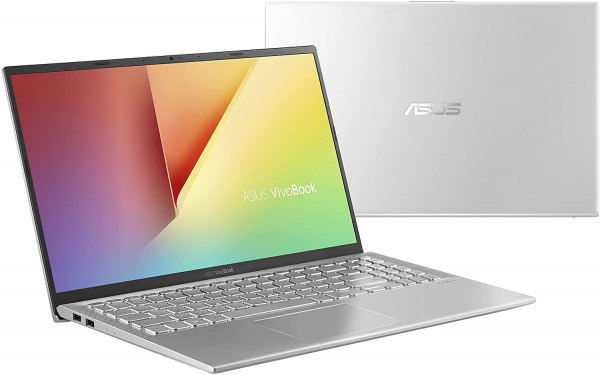
Construction
Asus offers a sober and elegant design with its Vivobook S14. This one presents a chassis mixing aluminum and plastic. The computer is solid in hand, despite a screen cover that tends to bend slightly, but nothing too frightening.
The PC has the Asus paw in terms of design, especially when opening. Once opened, the keyboard is raised slightly to provide more comfort to the user. To raise the keyboard, the Vivobook S14 chassis rests on the base of the screen. A technique already used many times on Asus products and which makes typing more pleasant while allowing to promote the entry of air into the ventilation grille located under the chassis.
The keyboard is successful, despite a typing that we would have liked a little more resistant. We particularly appreciate the absence of keys to the right of the Enter key (which is however very long on a line) which allows to avoid false manipulations. But the real argument of Vivobook actually lies in its ScreenPad, here in version 2.0, with a slightly reworked screen and revised interactions.
The principle of the ScreenPad is simply to place a touch screen in place of the trackpad. If we can compare the concept to that of the TouchBar of the MacBook Pro, it is actually very different. The ScreenPad thus offers two different uses. It is thus possible to use compatible applications, such as Spotify which transforms the screen into a music player, or Note which allows you to write in manuscript with your fingers, or even a numeric keypad. Other applications, such as Evernote which allows you to display notes on the trackpad or even a calculator, are available by default. Applications present, but unfortunately few.
The other advantage of the ScreenPad is to display a second screen, and thus to extend the display. In fact, this means that it is possible to display an Internet page, an Excel table or even a video on this small screen. Concretely, it is possible to let Twitch run on the ScreenPad by working on the main screen with a simple manipulation. But in reality, the manipulations are slow and often frustrating, the user having to do it several times before switching a window or navigating on the screen of the ScreenPad. A use which is actually more pleasant with a mouse connected to the PC, as it is difficult to juggle between the * trackpad * and the displayed touch screen.
Regarding the connections, the Vivobook S14 is complete. It offers a USB 3.0 Type-C port, a USB 3.0 Type-A port, two USB 2.0 ports, but also an HDMI port and a microSD reader. Everything is accompanied by the traditional headphone jack, but also by a proprietary port for recharging.
The Vivobook S14 can be easily disassembled using a precision screwdriver. Once the lower part of the keyboard is removed, you can easily access the bowels of the computer. However, only PC storage can be changed. It is thus possible to change the SSD, and even add a second, thanks to an empty slot available. The RAM is directly soldered to the motherboard.
As far as heating is concerned, the Vivobook S14 is exemplary. During our usual test protocol (Unigine Heaven benchmark for one hour), the PC did not exceed 40 ° C on the surface. Likewise, the breath was measured at 37 dB, which is a very discreet sound level under normal conditions. This is proof of a well-designed chassis that will not heat up, the result of Asus' work on tilting and air management.
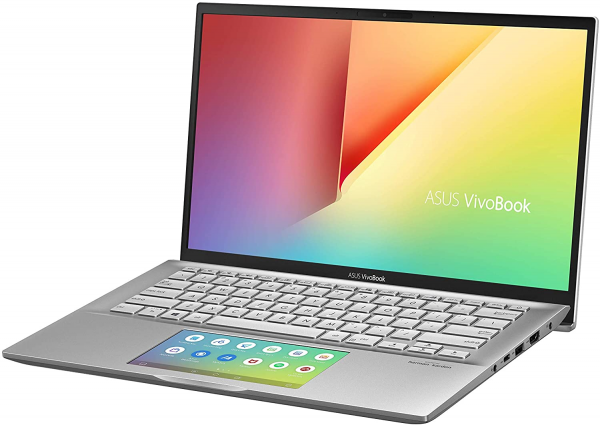
Screen
The Vivobook S14 has a 14-inch matte IPS screen with a resolution of 920 x 1,080 px. Asus always puts on its thin edges by offering a very appreciable screen / front ratio of 87%, leaving just room for its webcam.
The screen of the Vivobook S14 gave satisfactory results. Thus, the contrast measured by us is 1310: 1, which is very correct on a laptop. The color temperature is also very well balanced, since it is 6,680 K, very close to 6,500 K of the video standard. The screen thus does not draw towards red or blue. Finally, the respect for colors is a little disappointing, since the average delta E was measured at 6.2. On closer inspection, you can see that the greens, blues and mauves displayed are not faithful to the original colors.
The maximum screen brightness is correct, amounting to 315 cd / m². The screen is not subject to reflections, so it is possible to work serenely outdoors with the Vivobook. The remanence is also good, calculated at 13 ms, which is below the average of laptops which is 15 ms. This score, which is ultimately not very good, shows the limits of the IPS, but remains acceptable on a screen of this size (14 inches). The user will therefore not perceive too much "fuzzy streaks" on the screen during movements.
The second screen, the screePpad, is 5.6 inches, which is relatively large for a trackpad, and has a resolution of 2,160 x 1,080 px. It also offers a plastic coating anti-fingerprints, which gives a somewhat blurred appearance to the icons displayed on the screen.
Once under the lens of our probe, the ScreenPad screen reveals amazing results. Thus, the contrast was measured at 1,675: 1, which is excellent for a laptop. Likewise, the colors displayed are extremely faithful to the original colors, the average delta E being 3. Reds, sky blues and light greens are the only bad pupils in this area. However, the ScreenPad reveals its weaknesses in terms of temperature, since it rises to 7,830 K. The screen therefore turns blue, which can be seen with the naked eye. The maximum brightness is 206 cd / m² while the afterglow is 13 ms, as for the main screen. Sufficient brightness to work indoors, but which begins to become just outdoors, the icons becoming less visible due to reflections.
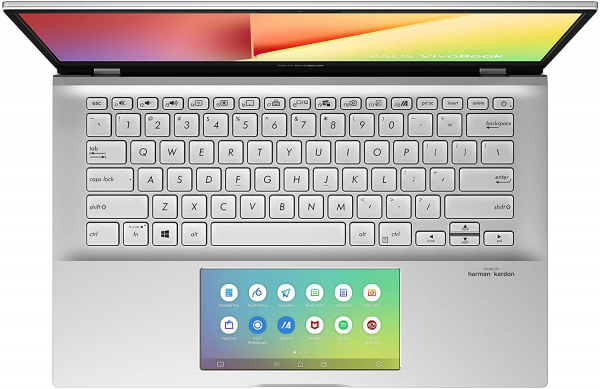
Performances
The Vivobook S14 is equipped with an Intel Core i5-8265U processor (4 cores, 8 threads, 1.6 GHz base frequency, 3.9 GHz turbo frequency), as well as 8 GB of RAM soldered to the motherboard. Storage consists of an SSD in M.2 format of 256 GB. A configuration which, theoretically, will bring enough power to work serenely.
During our usual test protocol (video compression, audio or 3D calculation), the PC reached the index of 86 on our test scale. This places it in the current average of mid-range ultraportables, neck to neck for example with the HP Envy Laptop 13, and logically below computers equipped with an Intel Core i7, such as the Zenbook S13. With such a PC, the user will be able to do advanced office automation, or even use software greedy in calculation.
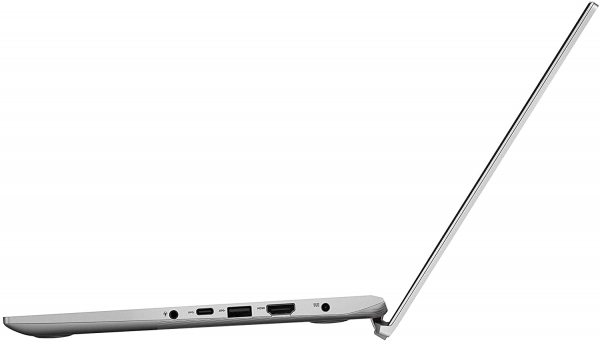
Mobility / Autonomy
The Vivobook S14 is a computer designed for mobility. If it is not one of the lightest PCs on the market with its 1.4 kg, or the thinnest with its 18 mm thickness, it will still be easily transported in a bag. Note that its 152 g charger is very light, in addition to being very compact.
The Vivobook S14 has a very satisfactory autonomy. During our usual test protocol (Netflix in Chrome, backlight off, ScreenPad off, headphones plugged in and brightness set to 200 cd / m²), the PC shut down after 7 h 39 min. A good result that the user can hope to double in simple office use, such as word processing. Thus, no need to clutter the charger during the day.
Audio
The speakers of the Vivobook S14 provide very good sound. No dynamic compression is to be deplored. In addition, the distortion is very slight. The voices coming out of the PC are clear and the sound when listening to music is very balanced. Only problem, and not least, the location of the speakers. Not only are they located at the front of the PC, under the chassis, but they also direct the sound directly towards the user, that is to say on his chest. The worst possible placement for laptop speakers. The sound is muffled when the user places their wrists in the writing position.
As for the headphone jack, it is experiencing difficulties in running current above the 88% mark. At this level, the user must be satisfied with a power of 90 mVrms, which forces him to favor a portable headset that does not consume a lot of power.
Conclusion
The Vivobook S14 is technically a good PC, but which is based on an idea that does not work very well, unfortunately. The ScreenPad is an interesting technology, but one that does not convince in use, as certain manipulations can be sluggish. Alas, it does not convince as much as the TouchBar of the MacBook Pro, which certainly did less, but did it better. Those who wish to save a few euros can turn to the model with a classic trackpad, the Vivobook S412.
Specifications

